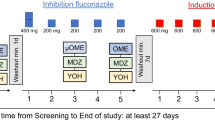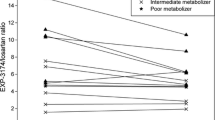Abstract
Objective
The purpose of this study was to identify the common time point to achieve hydroxylation index (HI: omeprazole plasma concentration/5-hydroxyomeprazole plasma concentration) reflecting AUCOPZ/AUC5OH-OPZ after intravenous (IV) and oral (PO) administration.
Methods
Twenty young and 28 elderly healthy subjects, including different CYP2C19 genotypes, were enrolled in the study. The young subjects received either 40 mg PO or 20 mg IV omeprazole, whereas the elderly subjects received 10 mg IV. The relation between AUCOPZ/AUC5OH-OPZ and HI was determined by Spearman’s rank correlation. Multiple stepwise linear regression analysis was performed to identify the common time point to calculate HI that reflects AUCOPZ/AUC5OH-OPZ after IV.
Results
In the correlation between HI and AUCOPZ/AUC5OH-OPZ IV at observed time points, HI3h showed the highest correlation coefficients (r = 0.894, p < 0.001) in all 48 subjects. The correlation of HI between IV and PO at observed time points showed that HI3h was highest (r = 0.916, p < 0.001) in 20 young subjects. Additionally, there was no significant difference between HI3h of IV and that of PO (12.9 ± 15.9 and 12.9 ± 15.1, p = 0.997). The regression equation of HI3h was the best to estimate AUCOPZ/AUC5OH-OPZ (AUCOPZ/AUC5OH-OPZ = 1.37 • HI3h + 0.18 • Age – 7.83, r 2 = 0.883, p < 0.001).
Conclusions
This study demonstrated that HI3h after omeprazole IV was able to estimate AUCOPZ/AUC5OH-OPZ, as well as HI3h after PO. Additionally, CYP2C19 activity can be estimated more definitely by using HI after omeprazole IV without intestinal absorption.




Similar content being viewed by others
References
Guerreiro AS, Neves BC, Quina MG (1990) Omeprazole in the treatment of peptic ulcers resistant to H2-receptor antagonists. Aliment Pharmacol Ther 4:309–313
Tybring G, Bottiger Y, Widen J, Bertilsson L (1994) Enantioselective hydroxylation of omeprazole catalyzed by CYP2C19 in Swedish white subjects. Clin Pharmacol Ther 62:129–137
de Morais SM, Wilkinson GR, Blaisdell J, Nakamura K, Meyer UA, Goldstein JA (1994) The major genetic defect responsible for the polymorphism of S-mephenytoin metabolism in humans. J Biol Chem 269:15419–15422
Chang M, Tybring G, Dahl ML, Gotharson E, Sagar M, Seensalu R, Bertilsson L (1995) Interphenotype differences in disposition and effect on gastrin levels of omeprazole-suitability of omeprazole as a probe for CYP2C19. Br J Clin Pharmacol 39:511–518
Furuta T, Ohashi K, Kosuge K, Zhao XJ, Takashima M, Kimura M, Nishimoto M, Hanai H, Kaneko E, Ishizaki T (1999) CYP2C19 genotype status and effect of omeprazole on intragastric pH in humans. Clin Pharmacol Ther 65:552–561
Furuta T, Shirai N, Sugimoto M, Ohashi K, Ishizaki T (2004) Pharmacogenomics of proton pump inhibitors. Pharmacogenomics 5:181–202
Furuta T, Ohashi K, Kosuge K, Zhao XJ, Takashima M, Kimura M, Nishimoto M, Hanai H, Kaneko E, Ishizaki T (1999) CYP2C19 genotype status and effect of omeprazole on intragastric pH in humans. Clin Pharmacol Ther 65:552–561
Shelepova T, Nafziger AN, Victory J, Kashuba AD, Rowland E, Zhang Y, Sellers E, Kearns G, Leeder JS, Gaedigk A, Bertino JS Jr (2005) Effect of a triphasic oral contraceptive on drug-metabolizing enzyme activity as measured by the validated Cooperstown 5+1 cocktail. J Clin Pharmacol 45:1413–1421
Christensen M, Andersson K, Dalen P, Mirghani RA, Muirhead GJ, Nordmark A, Tybring G, Wahlberg A, Yasar U, Bertilsson L (2003) The Karolinska cocktail for phenotyping of five human cytochrome P450 enzymes. Clin Pharmacol Ther 73:517–528
Zhu B, Ou-Yang DS, Chen XP, Huang SL, Tan ZR, He N, Zhou HH (2001) Assessment of cytochrome P450 activity by a five-drug cocktail approach. Clin Pharmacol Ther 70:455–461
Chang M, Tybring G, Dahl ML, Gotharson E, Sagar M, Seensalu R, Bertilsson L (1995) Interphenotype differences in disposition and effect on gastrin levels of omeprazole-suitability of omeprazole as a probe for CYP2C19. Br J Clin Pharmacol 39:511–518
Ieiri I, Kubota T, Urae A, Kimura M, Wada Y, Mamiya K, Yoshioka S, Irie S, Amamoto T, Nakamura K, Nakano S, Higuchi S (1996) Pharmacokinetics of omeprazole (a substrate of CYP2C19) and comparison with two mutant alleles, C gamma P2C19 m1 in exon 5 and C gamma P2C19m2 in exon 4, in Japanese subjects. Clin Pharmacol Ther 59:647–653
Chang M, Dahl ML, Tybring G, Gotharson E, Bertilsson L (1995) Use of omeprazole as a probe drug for CYP2C19 phenotype in Swedish Caucasians: comparison with S-mephenytoin hydroxylation phenotype and CYP2C19 genotype. Pharmacogenetics 5:558–563
Roh HK, Dahl ML, Tybring G, Yamada H, Cha YN, Bertilsson L (1996) CYP2C19 genotype and phenotype determined by omeprazole in a Korean population. Pharmacogenetics 6:547–551
Ishizawa Y, Yasui-Furukori N, Takahata T, Sasaki M, Tateishi T (2005) The effect of aging on the relationship between the cytochrome P450 2C19 genotype and omeprazole pharmacokinetics. Clin Pharmacokinet 44:1179–1189
Uno T, Niioka T, Hayakari M, Yasui-Furukori N, Sugawara K, Tateishi T (2007) Absolute bioavailability and metabolism of omeprazole in relation to CYP2C19 genotypes following single intravenous and oral administrations. Eur J Clin Pharmacol 63:143–149
Desta Z, Zhao X, Shin JG, Flockhart DA (2002) Clinical significance of the cytochrome P450 2C19 genetic polymorphism. Clin Pharmacokinet 41:913–958
Lin JH, Lu AY (1998) Inhibition and induction of cytochrome P450 and the clinical implications. Clin Pharmacokinet 35:361–390
De Morais SM, Wilkinson GR, Blaisdell J, Meyer UA, Nakamura K, Goldstein JA (1994) Identification of a new genetic defect responsible for the polymorphism of (S)-mephenytoin metabolism in Japanese. Mol Pharmacol 46:594–598
Sim SC, Risinger C, Dahl ML, Aklillu E, Christensen M, Bertilsson L, Ingelman-Sundberg M (2006) A common novel CYP2C19 gene variant causes ultrarapid drug metabolism relevant for the drug response to proton pump inhibitors and antidepressants. Clin Pharmacol Ther 79:103–113
Shimizu M, Uno T, Niioka T, Yaui-Furukori N, Takahata T, Sugawara K, Tateishi T (2006) Sensitive determination of omeprazole and its two main metabolites in human plasma by column-switching high-performance liquid chromatography: application to pharmacokinetic study in relation to CYP2C19 genotypes. J Chromatogr B Analyt Technol Biomed Life Sci 832:241–248
Landahl S, Andersson T, Larsson M, Lernfeldt B, Lundborg P, Regardh CG, Sixt E, Skanberg I (1992) Pharmacokinetic study of omeprazole in elderly healthy volunteers. Clin Pharmacokinet 23:469–476
Xie HG, Huang SL, Xu ZH, Xiao ZS, He N, Zhou HH (1997) Evidence for the effect of gender on activity of (S)-mephenytoin 4′-hydroxylase (CYP2C19) in a Chinese population. Pharmacogenetics 7:115–119
Andersson T (1991) Omeprazole drug interaction studies. Clin Pharmacokinet 21:195–212
Andersson T (1996) Pharmacokinetics, metabolism and interactions of acid pump inhibitors. Focus on omeprazole, lansoprazole and pantoprazole. Clin Pharmacokinet 31:9–28
Yasui-Furukori N, Takahata T, Nakagami T, Yoshiya G, Inoue Y, Kaneko S, Tateishi T (2004) Different inhibitory effect of fluvoxamine on omeprazole metabolism between CYP2C19 genotypes. Br J Clin Pharmacol 57:487–494
Rinetti M, Regazzi MB, Villani P, Tizzoni M, Sivelli R (1991) Pharmacokinetics of omeprazole in cirrhotic patients. Arzneimittelforschung 41:420–422
Andersson T, Olsson R, Regardh CG, Skanberg I (1993) Pharmacokinetics of [14C]omeprazole in patients with liver cirrhosis. Clin Pharmacokinet 24:71–78
Kimura M, Ieiri I, Wada Y, Mamiya K, Urae A, Iimori E, Sakai T, Otsubo K, Higuchi S (1999) Reliability of the omeprazole hydroxylation index for CYP2C19 phenotyping: possible effect of age, liver disease and length of therapy. Br J Clin Pharmacol 47:115–119
Ohnishi A, Murakami S, Akizuki S, Mochizuki J, Echizen H, Takagi I (2005) In vivo metabolic activity of CYP2C19 and CYP3A in relation to CYP2C19 genetic polymorphism in chronic liver disease. J Clin Pharmacol 45:1221–1229
Furuta T, Shirai N, Sugimoto M, Ohashi K, Ishizaki T (2004) Pharmacogenomics of proton pump inhibitors. Pharmacogenomics 5:181–202
Pilbrant A, Cederberg C (1985) Development of an oral formulation of omeprazole. Scand J Gastroenterol 108(Suppl):113–120
Author information
Authors and Affiliations
Corresponding author
Rights and permissions
About this article
Cite this article
Niioka, T., Uno, T., Sugimoto, K. et al. Estimation of CYP2C19 activity by the omeprazole hydroxylation index at a single point in time after intravenous and oral administration. Eur J Clin Pharmacol 63, 1031–1038 (2007). https://doi.org/10.1007/s00228-007-0331-3
Received:
Accepted:
Published:
Issue Date:
DOI: https://doi.org/10.1007/s00228-007-0331-3




